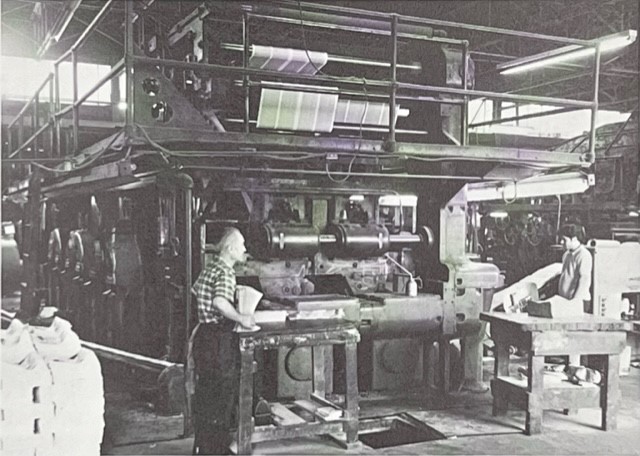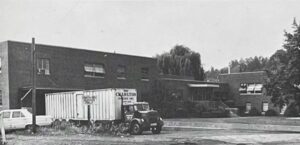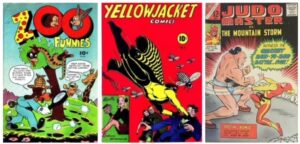By Joseph M. DiRienzo
Over the course of its history, a low-lying piece of land along the west bank of the Naugatuck River between Derby and Ansonia became known as the “Meadows” or “Flats.” Canals built along the river drove the development of industrial villages during the early 1800s. Because of the topography of the Meadows, however, commercial development of the land did not start until the 1940s. One of the first businesses to take a chance building on this flood-prone strip of land was Charlton Publications. By the late 1950s, this publishing-printing-distributing organization filled a seven-and-a-half-acre property and was home to some of the most accomplished artists and writers in the comic book industry.
John Santangelo and the Printing Business
The origins of Charlton Publications involves sheet music, a prison sentence, and an unlikely friendship. In the early 20th century, an Italian immigrant named John Santangelo purchased a printed copy of sheet music in New York when his wife wanted a copy of the lyrics to “Shuffle Off to Buffalo.” The 35-cent price seemed unreasonable to Santangelo, however, so he decided to purchase 50 songs and have their lyrics printed on inexpensive sheet paper. He sold the lyric sheets to dealers in Manhattan for 10 cents apiece and divided the profits 50/50 when the dealers resold to customers.
By the mid-1930s, Santangelo had close to five hundred song-sheet dealers in New England and the Mid-Atlantic who sold a total of seven million copies a month. He switched printing houses regularly to circumvent pressure from the American Society of Composers, Authors, and Publishers (ASCAP) on union printers. In 1934, Santangelo pled guilty to criminal infringement charges in Connecticut and received a-year-and-a-day prison sentence in the New Haven County jail. US District Attorney Valentine J. Sacco later referred to Santangelo as “a kingpin in the song sheet racket.”
While in prison, Santangelo met disbarred lawyer Edward Levy and the two men formed a publishing enterprise upon their release. Santangelo reached an agreement with ASCAP to pay a licensing fee for the publication of lyrics. He expanded a printing business he had started in Waterbury and moved it to Derby—his wife’s hometown.
The business assembled a staff of advertising agents, salesmen, artists, and writers based in New York City. Since both men had young sons named Charles, they christened the new company T.W.O. Charles. By 1941, they were printing their song lyric sheets, “Big Song Magazine” and “Radio Song Hits,” under the name Charlton Press. In 1942, they began printing a more professional-looking lyrics sheet called “Hit Parader” with a new company name, Charlton Publications, and sold six hundred thousand copies of the magazine per month. Charlton continued to publish two leading song-lyric magazines, Hit Parader and Song Hits, for decades while also developing similar titles for country & western, rock, and soul music.
Charlton Publications
In addition to music magazines, Charlton Publications went on to become a significant second-tier publisher of comic books. Charlton Comics began operations in 1944 with the superhero comic, Yellowjacket Comics #1—published under one of the company’s many name iterations, Frank Comunale Publications. Zoo Funnies in 1945 was the first comic they published under the Charlton Comics name. Studio artists such as Al Fago, Dick Giordano, and Joe Gill (among others) drew, wrote, and edited Charlton Comics products. Charlton Comics also picked up inventory stories and repackaged them as their own when other publishers went out of business at the end of the “golden age” of comic books in the mid-1950s.
Shortly after World War II, Santangelo built a new printing plant on land he purchased in the 1940s near a railroad siding in the Meadows. The new plant and its location allowed Charlton to become unique in the publishing business as an “all-in-one operation.” Their subsidiaries, Charlton Press and Charlton Comics, among others, all operated together under one roof in a modern facility containing one hundred thousand square feet of space. There were seven high-speed printing presses, modern typesetting and binding equipment, a very early IBM computer on site, and a fleet of delivery trucks.
Around this time, Charlton began developing its own heroes, including Captain Atom, Peacemaker, and Judomaster. The company acquired Flash Gordon, Popeye, Beetle Bailey, and other titles from King Comics in the late 1960s and produced comic book spinoffs from famous Hanna-Barbera television animation series including Yogi Bear, The Flintstones, and Rocky & Bullwinkle.
Disaster and Recovery
Two major hurricanes in August 1955 almost permanently destroyed the Charlton enterprise. All 129 acres of the property were under 18 feet of water and the disaster destroyed three hundred thousand dollars of paper, artwork, and printing plates. Santangelo successfully rebuilt the business, despite having to absorb the loss because, at the time, there was no flood insurance in Connecticut.
Ed Levy retired in the mid-1960s and sold his half of the company to the Santangelos. At various points, other members of the Santangelo family got involved in the business, including their sons John and Charles. Santangelo Sr. died in 1979 and Charlton Comics went out of business in the mid-1980s, but DC Comics had already acquired most of their superhero characters. The full Charlton business closed in 1991 and officials razed the Charlton plant within the decade.
After almost half a century in business, the notoriety and legacy of Charlton Publications was its Charlton Comics subsidiary. In spite of receiving low salaries, dedicated and talented artists, writers, and editors created wonderful characters and adventures. While John Santangelo was not the creative mind behind Charlton Comics, he was the visionary printer who found a way to keep the presses running, even through the most difficult of times.
Joseph M. DiRienzo, PH.D. is an Emeritus Professor of Microbiology, University of Pennsylvania and Member of the Board of Directors of the Derby Historical Society. He writes the DHS newsletter and a weekly local history post for the society’s Facebook page.













